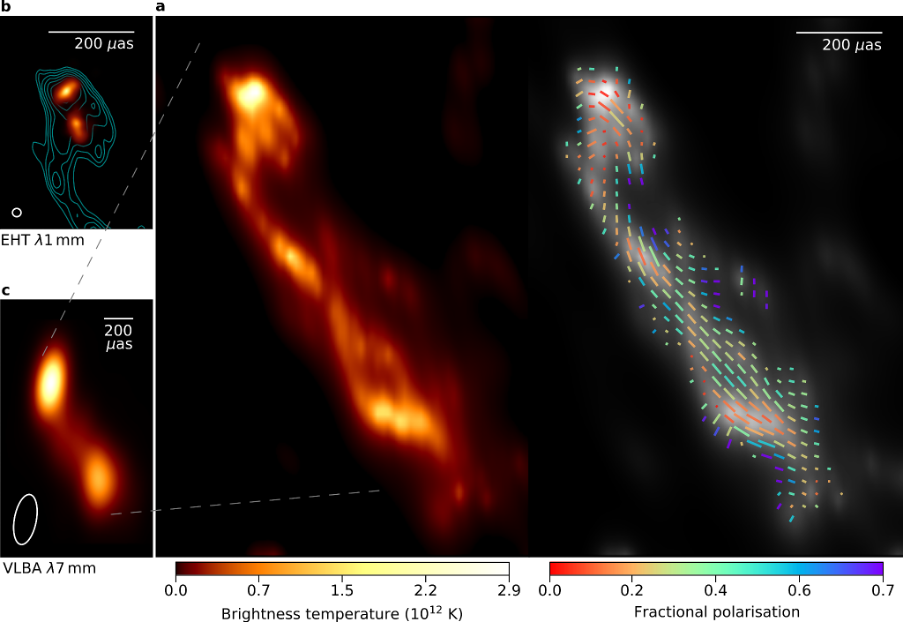
Filamentary structures as the origin of blazar jet radio variability
Antonio Fuentes
Supermassive black holes at the center of active galactic nuclei (AGN) power some of the most luminous objects in the Universe). In particular, blazars are a subclass of AGNs where a relativistic jet of plasma is ejected from the surroundings of the central engine and points towards Earth with a very low inclination angle, which makes them very bright at radio wavelengths as a consequence of Doppler beaming and suitable for very long baseline interferometric (VLBI) observations.

However, for the past decades VLBI observations of blazars have revealed only funnel-like morphologies with little information of the ejected plasma internal structure (e.g., Jorstad et al., 2005), or lacked the sufficient dynamic range to reconstruct the extended jet emission (e.g., Kim et al., 2020), and so the transversal morphology of these objects has remained hidden.
In March 2014 we observed the archetypical blazar 3C279 at 22 GHz (or 1.3 cm) with the space VLBI mission RadioAstron (Kardashev et al., 2013), a 10-m space radio telescope onboard of the Spektr-R satellite, and an array of 23 ground-based radio telescopes spanning baselines distances up to the whole Earth diameter, most of these sites belonging to the European VLBI Network. The highly eccentric orbit of the space antenna provided us with ground-space fringe detections of the source up to a projected baseline distance of 8 Earth diameters, which corresponds to an angular resolution of 27 microarcseconds (µas), an order-of-magnitude improvement in resolution compared to previous results at similar wavelengths and comparable to that obtained by the Event Horizon Telescope (EHT) at 1.3 mm. Nonetheless, in contrast to the EHT observations in 2017, the large number of supporting antennas on Earth enabled high dynamic-range observations, which in addition to the ultra-high resolution provided by the space antenna resulted in the image presented in Figure 1.
Leveraging on novel image reconstruction techniques, such as Regularized Maximum Likelihood (RML) methods (e.g., Chael et al. 2016; Akiyama et al. 2017), we were able to recover, with microarcsecond resolution, a pattern of helical filaments emerging near the jet base and extending up to 175 pc downstream. Although our observations of 3C279 were performed 3 years before, we can see in Figure 1 an agreement of the innermost structures between our image at 1.3 cm and that of the EHT at 1.3 mm, with the exception of the filamentary extended structure, which we attribute to our larger dynamic range and possible changes in the source. Considering previous estimates of the jet properties in 3C279, such as the flow Lorentz factor, these filaments can be interpreted as Kelvin-Helmholtz plasma instabilities originated in a kinetically dominated jet. The fact that the emission along them is brighter at locations separated by half a wavelength is consistent with a differential Doppler boosting occurring within the filaments. These scenario leads to a reinterpretation of the so-called ‘traveling components’ in radio jets, as are we can see in our image, there are no shock waves propagating through a uniform jet (Marscher & Gear, 1985), but a pattern of helical plasma instabilities modifying the local properties of the flow and, hence, its radio emission.
In addition, RadioAstron provides full polarimetric capabilities, so we could recover information about the magnetic field threaded to the jet in 3C279 through its linearly polarized emission (see rightmost panel of Figure 1). The source is mildly polarized (around 10%) and the electric vector position angle is predominantly aligned with the jet propagation direction, which is consistent with a helical magnetic with a strong toroidal component. Furthermore, most of the emission seems to be located left to the main jet axis, an effect we have observed in relativistic magnetohydrodynamic simulations of jets at the parsec scale (e.g., Fuentes et al. 2018, 2021). This allows us to infer a flow Lorentz factor of ~13 at the time of observation and a possible helical magnetic field rotating clockwise, as seen in direction of the flow motion. In summary, the findings presented in this work strongly suggest that blazars have a complex and rich internal structure beyond the usual funnel-like morphologies reported by former VLBI studies, and challenge previous assumptions on the radio variability of these objects.
More information:
‘Filamentary structures as the origin of blazar jet radio variability’. Fuentes et al. Nat Astron 7, 1359–1367 (2023)